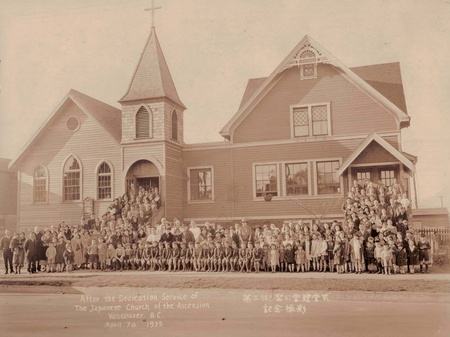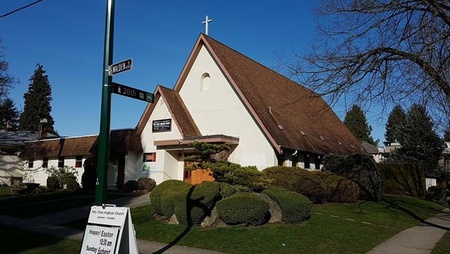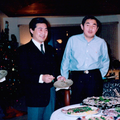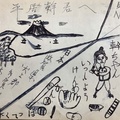In April, 1949, approximately four years after the end of the war, the ban on Japanese Canadians returning to the coast was lifted and some started moving back to the Vancouver area. Unlike before the war when most lived in or near Steveston or the Powell Street area, many of these returnees ended up living scattered in various parts of the city.
Consequently, some of the Anglicans among them began to attend non-Japanese Canadian Anglican churches located near their homes,1 while yet others attended churches of other Christian groups. Those Anglicans who did move back to their pre-war neighborhoods soon discovered that their former church properties (Church of the Ascension, Holy Cross Mission, and Holy Cross Extension Property) were no longer open to them.
Reverend Gale returned to Vancouver in 1952 and began the difficult task of locating the scattered Anglican returnees and gradually reorganizing the church work. Eventually he was allowed to hold services on Sunday afternoons in the basement and later in the chapel of St. James church. Later, services for Japanese Canadians were also held in St. George’s Church.
In 1955, the Diocese of New Westminster gave the building of the Catholic Apostolic Church, which had been recently donated to the diocese, to the Japanese Canadian mission. It was old and in constant need of maintenance. While supervising repairs to this building, Gale suffered a heart attack and soon passed away.
Although startled by the loss of their previous church buildings, the Japanese Canadian Anglicans were understandably hesitant to ask for information about their fate. However, in 1953, Timothy Nakayama, a young theology student who was doing field work under Gale, happened to ask the diocese bishop and treasurer what had happened to the church properties. He received a very abrupt reply: “They were relinquished”. Not wishing to make trouble, he did not follow up on this answer, and a long period of silence regarding the issue continued.2
However, in 1988, Trevor Bamford, a student at Vancouver School of Theology (VST), wrote a master’s thesis that dealt with this issue. His was followed by that of another VST student, Michael Hemmings. Neither was able to determine exactly what had happened to the church properties and the proceeds from their sale, why they were sold, and why the diocese kept silent about it. Bamford concluded with the sentence: “Why this has remained a secret for 40 years is a question that needs to be answered”.3
Bamford’s thesis was eventually read by the Reverend John Shozawa, and this led him to raise the matter with the bishop, Michael Ingham. Like Nakayama, he was unable to get a satisfactory reply.4
Years later, Gregory Tatchel, a retired businessman and student of VST, was chatting with longtime Holy Cross Church member Basil Izumi, who, in the course of the conversation, briefly expressed his lingering bewilderment about what had happened to the churches.5 The conversation eventually spurred Tatchel to choose this question as the topic for his master’s thesis titled Relinquished: The Seat of Deitei Supream Us Dispossest.6 To support his investigations, he formed a committee of ten Japanese Canadians, which called itself the JC-VCC (Japanese Canadian Vancouver Consultative Committee) after an ecumenical committee which had advocated strongly for the human rights of Japanese Canadians during the war.
Three members of this new JC-VCC had actually been members of the two churches that had been sold: Joy Kogawa and Timothy Nakayama had spent their early childhood in the Church of the Ascension of which their father was priest, and Basil Izumi had attended the Sunday school and the kindergarten at Holy Cross Mission. The specific focus of Tatchel’s research was the sale of the Japanese Canadian Anglican properties during and after World War 2, and what was done with the proceeds from those sales.
After months of persistent and meticulous research during 2008 and 2009, Tatchel and the committee made the following startling findings: The three Anglican Japanese Canadian properties (Holy Cross Mission, Church of the Ascension, and Holy Cross Expansion Property), all of which had been paid for by the Japanese Canadian Anglicans themselves, were transferred to the Diocese of New Westminster in 1937, 1938, and 1941 respectively. In 1945, the year the war ended, two of the properties (Holy Cross Expansion Property and Church of the Ascension), were sold by the diocese, and the third property (Holy Cross Mission) was sold in August of 1949.
These sales were conducted at prices far below the appraised value of the properties, and without consulting or even informing the Japanese Canadian Anglicans. The stated rational was that the Japanese Canadians would not be returning to Vancouver, and therefore the need for these properties was “nil”. In the case of the Church of the Ascension, it was also stated that the building was “obsolete”, in spite of the fact that it was just over ten years old and clearly in good condition.7

The sale of the Holy Cross Mission property was particularly shocking as it had occurred four months after the Japanese Canadians had received legal permission to return to the west coast (some were already arriving). Perhaps the most shocking finding of all was that the proceeds and accrued interest from the sales had been placed in the Bishop’s Endowment Fund, from which the Bishop’s salary is paid.8
Based on these unusual transactions and the history of “virulent racism” which had existed not only in BC society at large but also within the Anglican Church and its leadership, Tatchel strongly made the case that these sales were motivated by institutional racism within the church and were intended to help ensure that the Japanese Canadians would not return to the west coast. He additionally demonstrated that the church leadership had tried to hide the facts through a ‘code of silence’, as was particularly exemplified by the fact that there was absolutely no mention of the 1500 Japanese Canadian Anglicans who had been uprooted from the BC coast or of their church properties in Pacific Pilgrims, a publication in 1979 celebrating the centenary of the Anglican Church in British Columbia. In short, the Diocese of New Westminster had committed a serious historic and racially motivated injustice against its Japanese Canadian members, and had consciously covered it up.9
On November 10, 2009, the committee formally presented its findings to the diocese, and soon received an apology from Bishop Ingham. On March 14, 2013, a formal apology was made by the Anglican Church of Canada for its treatment of the Japanese Canadians and their church properties.
Notes:
1. Roy, 106.
2. Rev. Timothy Nakayama’s affidavit in Tatchel, Appendix IX, 4.
3. Quoted by Tatchel, 50
4. Rev. John Shozawa’s affidavit in Tatchel, Appendix VIII, 8-9
5. Tatchel, personal conversation with the writer.
6. Tatchel, 2009.
7. The good condition of the Church of the Ascension building after the war and the sense of loss that would have been felt by the Anglican Japanese Canadian returnees at the loss of the church buildings that were so closely linked to their childhood memories is corroborated by Joy Kogawa’s poignant anecdote regarding her unplanned visit to the building while taking a walk in 1957: “I found the church still standing. There was no one around and the door was not locked. I entered the large beautiful space which was empty and stripped of all furnishings, but I was able to savour happy memories of being in the church with my mother, sitting in the pews, putting a nickel into the collection plate, or holding a Lenten box. The lovely wooden floor and walls were in such contrast to the old building used by Holy Cross on East 11th or the simple re-erected kindergarten building from Slocan which became the new building of the Church of The Ascension in Coaldale, Alberta” (Tatchel, Appendix X, 2).
8. For a more detailed summary of the various transactions and findings, see Tatchel, 68-9, and Appendix IV, 107-115.
9. Tatchel, especially 91-98.
* This series is an abridged version of the original article titled, “A Japanese Canadian Child-Exile: The Life History of Basil Izumi,” originally published in The Journal of the Institute for Language and Culture, Konan University, Vol. 22, pp. 71-108 (March 2018).
© 2018 Stanley Kirk







